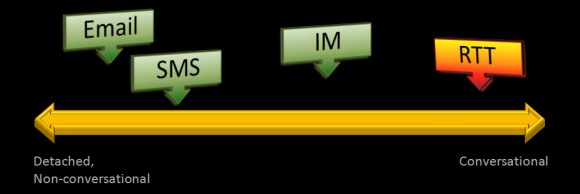This increasing number of communication services (and not just text, but also voice and video) means that we now have a much larger palette of communication methods to our disposal than ever before. Which of this growing set of tools we end up choosing at a given time depends very much on context and needs. In other words, most people have a suite of available alternatives and they pick one depending on practicalities and other circumstances. This choice is however not solely a matter of preference for all of us. Some user groups are constrained in their choice. This could be because of economic, educational or cultural reasons, but equally users can be restricted by abilities. For example, those users who because of their hearing loss cannot use voice communication will face a more limited choice in comparison with their hearing peers. For these citizens, text communication might need to serve as a substitute, rather than an alternative to voice telephony. Under those conditions, real-time text is a much more equivalent choice than, for example, SMS or email.
Indeed, not all forms of text communication are the same in terms of experience and the needs that they meet. Obviously, different services have different technical and economic characteristics, and there are societal and cultural factor at play too (some services will have much stronger adoption amongst certain demographies or socio-economic groupings for example). From a user experience and needs perspective, text services can be classified on a spectrum from detached (non-conversational) at one end of the spectrum to fully conversational at the other end.

True conversational communication is then characterised as follows:
Real-time text is the term we use to refer to those text communication systems that offer the most conversational experience in text, and as such is equivalent to voice telephony or direct video communication. It can exist as a unimodal product, or can be a component of multimodal communication models such as Total Conversation. In order to achieve this high level of interactivity, text usually flows character-by-character in (almost) real-time (although word-by-word might be an acceptable alternative, particularly suited to packet data networks).
Next: Interactivity and Relay Services